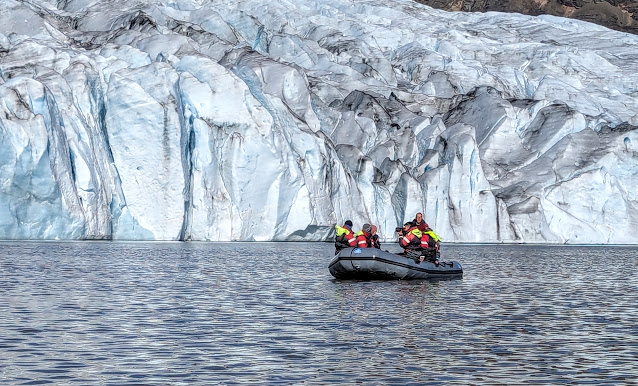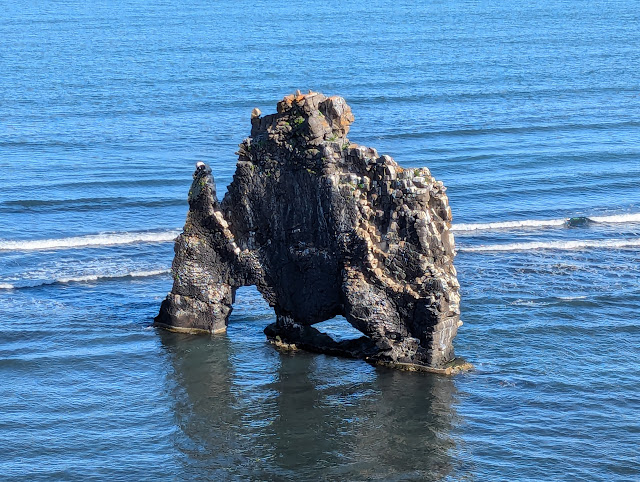The wonderful, incredible, otherworldly island of Iceland. WOW, what an amazing country! My friend Linda and I spent three weeks here, exploring Reykjavik and its neighborhood for about a week, and driving around the perimeter (the "Ring Road") for about two weeks.
As you might already know, Iceland is a volcanic island. It "grew" out of the Atlantic Ocean through volcanic eruptions between the North American and the Eurasian tectonic plates. Eruption after eruption of lava accumulated, first on the sea floor and eventually on the island that the lava created. Now Iceland straddles these plates and continues to grow as the plates themselves continue to pull apart, about an inch / 2.5 cm per year.
The island is about the same size as Pennsylvania in the US, and about twice the size of Nova Scotia in Canada. Population is about 400,000, GDP around USD 30 billion, median income is around USD 62,000 (2022, CEIC and World Bank data). Principal sources of revenue are tourism, fishing, aluminum, information technology, and life sciences. Cost of living is high (about 30% higher than the US, since practically everything in Iceland must be imported). About 20% of the land in Iceland is protected by National Parks and Reserves. Overall wellbeing, health, and wellness indicators are similar in all Nordic countries, are comparable to Canadian and are slightly higher (better) than American indicators (World Bank data).
REYKJAVIK
The capital city of Iceland is Reykjavik, located in the southwestern part of the country. The city is fun, complex, and touristy. It is dominated by Hallgrímskirkja, the largest church in Iceland, seen here at the end of Rainbow Street.
Although Iceland has been inhabited for more than a thousand years, many of its buildings are not very old. This is Iceland's Parliament Building; it is about 140 years old.
Many buildings in Reykjavik are fairly new, and some of them are pretty architecturally adventurous, I'd say. This is the Harpa Concert Hall and Conference Centre, opened in 2011
Built around six old water storage tanks, the Perlan Centre is a wonderful attraction that describes and explains Icelandic culture and natural history. The Perlan includes an glacial ice cave, a planetarium, interactive displays, and fabulous views of the city.
Public art is abundant, and includes this iconic sculpture, Sun Voyager, along the waterfront.
More about Reykjavik here: https://photos.app.goo.gl/qmwVt9om2fWeAJhY7
THE GOLDEN CIRCLE
The Golden Circle is a 120 mile / 190 km loop through southwestern Iceland, near Reykjavik, that provides a great introduction to the main geological and natural features of Iceland. If you have only one day in Iceland, this is the tour to take!
Oxararfoss (foss means falls in Icelandic) a waterfall along the Öxará River in Þingvellir (Thingvellir) National Park, the place where the first known application of democratic self governance happened. In Old Icelandic, Þing means “assembly” or “meeting”, and völlur means “field”. Add them together and you have the “assembly place” of Þingvellir.
This rift valley in Thingvellir is created by the slow separation of the North American and the Eurasian tectonic plates. The plates are moving away from each other at about 1 inch / 2.5 cm per year.
The Kerið Crater is about 55 metres / 180 feet deep, 170 metres / 560 feet wide and 270 meters / 880 feet in circumference. Geologists believe that it was once a cone shaped volcano. After it erupted (est 6,000 years ago), the remaining material settled and formed this water filled caldera
Iceland is a volcanic island that straddles two continental plates, so you'd expect some geothermal activity, right? Well, we got lots of it, including many hot springs, thermal pools, and even an occasional geyser, like this one that erupts every 5 - 10 minutes. In Geysir Hot Springs, a VERY popular tourist attraction!
The Golden Circle: https://photos.app.goo.gl/wn5aDs6sfKWVTbvH8
THE RING ROAD
The Ring Road is the road that goes around the island, mostly staying pretty close to the coast. We drove around the whole island, putting over 2,300 miles / 3,800 kms on our rental car. It was spectacular!
After visiting a few waterfalls (they are everywhere in Iceland!), our adventures continued here at the Sólheimajökull (jökull means glacier in Icelandic). It is a beautiful glacier that, unfortunately, is melting quickly. Estimates are that it loses about 20 meters / 66 feet in thickness and 60 meters / 200 feet in length each year. In any case, nine of us joined our guide Lucy for a hike on the glacier. We strapped on our crampons, got into our safety harnesses, donned our helmets, and picked up our ice axes, and off we went for a 90 minute introduction to the glacier and to some basic ice hiking / climbing skills. It was pretty great!
Icebergs "calve" off the face of glaciers, and we saw icebergs like this in several lagoons around the Vatnajokull. We took a RIB (rigid inflatable boat) out into the Fjallsárlón (sárlón means lagoon) for a close up tour of the icebergs and the glacier that spawned them. Great, informative boat ride
Svartifoss (foss means waterfall in Icelandic) is a beautiful waterfall in the Vatnajokull National Park. Notice the columnar basalt along the sides. Iceland is a volcanic island, and much lava becomes basalt with enough time and pressure. When basalt cracks, it tends to do so in long hexagonal columns like this.
A typical road view near Stokksnes, in southeastern Iceland. Notice the wide multicolored gravel slope, a scree field, on the right
Selfoss is one of three beautiful waterfalls along the Jökulsá á Fjöllum river in northeastern Iceland.
Waterfalls are plentiful in Iceland. Fed by glaciers and by rainfall, they pop up frequently. This is a particularly beautiful one called Godafoss. Legend has it that a local leader threw statues of his Norse gods over this waterfall when Iceland "officially" became a Christian nation around 1,000 CE
Scenic splendor in the Highlands, on the way to the Westfjords (in northwestern Iceland). Notice the glacially carved U-shaped valley
Lots of cool modern architecture in places besides Reykjavik, like this Lutheran Church in northwestern Iceland. The people of Iceland are not particularly religious and rarely attend services, but the government spends money to keep churches open and in good repair. This one is located in Blönduós.
Hvitserkur Basalt Rock Stack: Erosion can do amazing things. We saw lots of sea stacks, arches and caves where the sea meets the lava. One of the most unusual formations was this one, called the Hvítserkur, a 49-foot (15-meter) tall basalt stack. The unusual geological formation has two open spaces at the base, which gives it the appearance of a dragon drinking water
Iceland has more sheep than people, about 500,000 of them. They are raised for wool and for meat, and they appear to have the right of way along Icelandic roads. Farmers are apparently not concerned about road kills. It happens rarely, and when it does, the driver is automatically held responsible and must pay the market value of the sheep to the owner. Mostly when sheep hear or see cars coming, they scamper away, like this little flock did when we approached
Iceland has LOTS of waterfalls like this, just a little waterfall in one of thousands of ravines carved by water over long periods of time. We managed to visit the famous waterfalls, but we were also very happy to find secluded surprises like this one, near Drangsnes in the Westfjords
Iceland, being so geothermally active, has many hot springs and pools. They seems to be a primary place for meeting up with friends and neighbors. This one is roadside near Drangsnes, but was too hot for safe use. The developed pools in town were recommended
While in Drangsness in the Westfjords, we visited a fishing dock. By good fortune we watched a crew of fishermen unload their catch: fourteen tons of cod in one day! After the boat was unloaded, the fork lift driver invited us to join him at the fish sorting plant, where the fish were sorted by weight and shipped off to various fish processing plants. That evening, we had cod at our guesthouse; I've never had fish that was so good and so fresh!
Our Suðureyri highlight (also in the Westfjords) was getting a glimpse of the northern lights. We were lucky to have a clear night, so between 1:00 and 2:30 am we watched these amazing displays of light slowly dance across the night sky.
What a treat! Quite special and unexpected!
On our way back to Reykjavik we passed through the Snaefellsnes ("Snow Mountain") peninsula, which is home to much dramatic scenery at the Snaefellsjokull National Park. This park, the third of three National Parks we visited in Iceland, preserves and protects the glacier, the active volcano below it, and the land around the mountain. Another fabulous National Park
More about the Ring Road here:
https://photos.app.goo.gl/kxgkdYmS8bQKJ8J38
A wonderful visit, with fun stuff to do in lots of amazing places in Iceland. Thanks to Linda for great travel companionship and the many wonderful guides, hosts, and fellow travelers we met along the way!
Nordic Blogs:
Nordic Overview:
https://lotsofamazingplaces.blogspot.com/2024/10/amazing-places-in-nordics.html
Iceland:
https://lotsofamazingplaces.blogspot.com/2024/10/amazing-places-in-iceland-2024.html
Norway:
https://lotsofamazingplaces.blogspot.com/2024/10/amazing-places-in-norway-2024.html
Sweden:
https://lotsofamazingplaces.blogspot.com/2024/10/amazing-places-in-sweden-2024.html
Denmark:
https://lotsofamazingplaces.blogspot.com/2024/10/amazing-places-in-denmark-2024.html
Finland:
https://lotsofamazingplaces.blogspot.com/2024/10/amazing-places-in-finland.html
Estonia:
https://lotsofamazingplaces.blogspot.com/2024/10/amazing-places-in-estonia-2024.html
To the Nordic (Norway, Iceland, Denmark, Sweden, Finland, Estonia) Overview:
https://lotsofamazingplaces.blogspot.com/2024/10/amazing-places-in-nordics.html

























Comments
Post a Comment